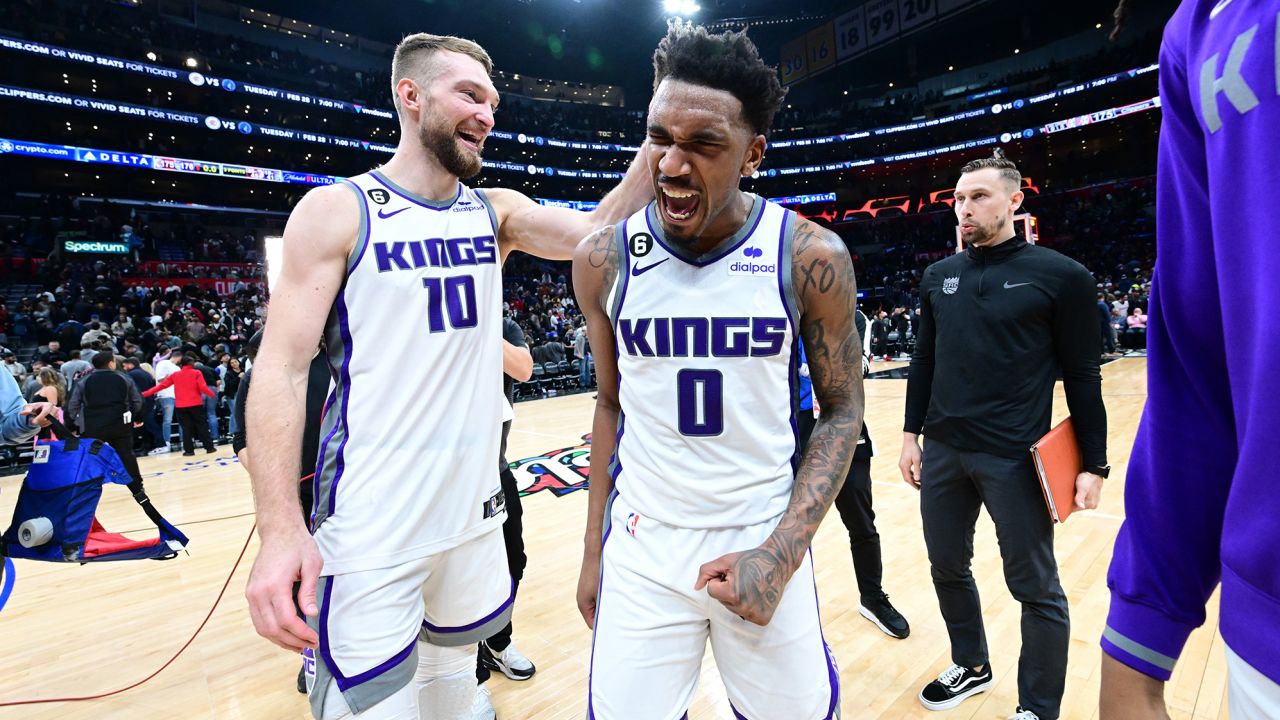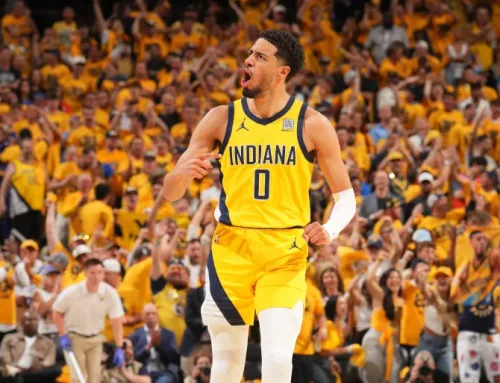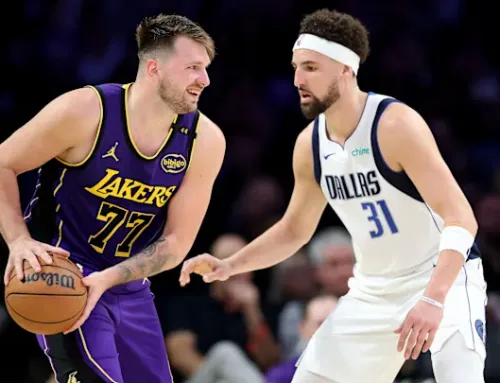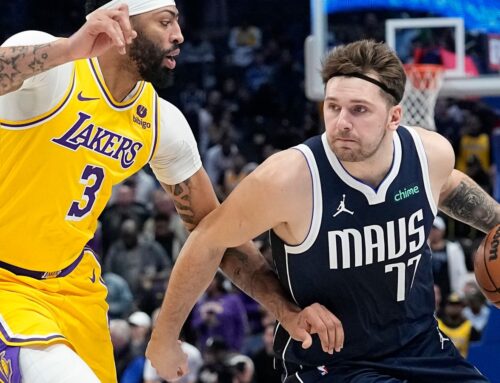By Avi Tyagi
The Kings Emerge as Contenders in a Muddled Western Conference
Since the analytics movement era entered the national spotlight, the NBA landscape has shifted every season due to at least one major schematic shift per campaign. 2013-14 was marked by the Spurs’ popularization of international sets and a culmination of years of successful development and international recruiting. In response, the league accelerated upon several of its under-the-radar, burgeoning trends. The time period from 2015-18 was marked by several different changes to dramatically shift the league. Teams took an average of 7 extra 3s per game, heavily influenced by the Warriors. The success of the Cavs’ and Rockets’ switching defense opened up a radical new style against the ball screens set higher up the court than ever before. The league sized down as shooting and defensive versatility became a premium. The Warriors (among several other teams) began prioritizing off-ball sets with multiple counters that could generate efficient shots for shooting guards, combo guards, and certain superstar wings. In such an environment, feel became a priority among bigs. The Nikola Jokic era was beginning out west. Then, 2018-19 happened.
2018-19 is the first year of the fully-modernized, spaced-out NBA. After a long, arduous path, finally, we were here. The freedom of movement rule changes further prompted coaches to place a greater emphasis on running off-ball sets for primary weapons around star ball handlers. In an age of new stars, anyone from Devin Booker to Jamal Murray to Jayson Tatum could run sets traditionally reserved for nominal 2-guards and decimate opponents more effectively than ever with an ever-expanding portfolio of complex offensive actions. The changes in shot selection were drastic. Whereas in 2017-18, 15% of all shots were long mid-rangers (14+ feet out per Cleaning the Glass), those same shots became only 12% of the league’s shot diet in 2018-19. This season, that number has dipped below 10%. In place of settling for long middys was a focus on drives and kick outs. Per NBA.com, teams averaged an extra 3 drives per game and completed a pass on 6% more of their drives from 2017-18 to 2018-19. Paint touches have always been a premium, but much as soccer shifted to cutbacks and filling in the premium spaces later in a possession rather than sitting down and staying put for the entire sequence, basketball too shifted from slow, methodical post touches to quick duck-ins, cuts, and drives through mostly empty lanes. The early era foul baiting and increased usage of transition-take-fouls captured the headlines, but the underpinnings of a new era nestled into the back pages. As those issues were cleaned up, the modern era’s sleek new game stepped into the forefront.
The first great offensive team of this new era were the Quin Snyder Jazz. Headlined by Donovan Mitchell, this offense thrived off of continuity ball screens. If an action ever fizzled out, a capable playmaker made their way through a maze of screens and confusion on the backside to attack once more. With Mike Conley, Joe Ingles, Jordan Clarkson, Bojan Bogdanovic, and of course, Donovan Mitchell, the Jazz created offense with an assortment of excellent shot creators, distributors, and play finishers. While no player was an MVP candidate, the assortment of quick thinkers, creative off-ball sets, and high-feel offensive players created a top-3 offense for two consecutive seasons (2020-21, 2021-22). They were by no means perfect (often struggling to get the line, generate easy paint touches, or play with pace) but they got into sets with tempo so as not to make an opponent of the shot clock as well. The implosion of the Jazz over two consecutive playoff runs was not about Gobert’s defense or the Utah offense. Rather, it was about the collective defense and Gobert’s offense. With immense trust in the system, Gobert was a fantastic defender who could teleport across the lane to deter shots, hold up against almost every big in an isolation matchup, and demolish layup attempts within his vicinity. Oppositions’ 5-out offensive approaches worked because the Jazz provided reactive shot deterrence but little active ball pressure. Royce O’Neale and Mike Conley could slide with defenders, but were not tangible defensive playmakers and could not afford to disrupt offensive players’ airspace without being laterally compromised. In addition, the playoff setting exposed the soft underbelly of their off-ball defensive principles. The Jazz struggled to keep their weakest link out of offensive actions through proactive switching and were left to fend for themselves in countless 4 v 5s. On offense, Gobert struggled to generate advantages for himself or teammates, making it even easier for teams like the Clippers to assign longer wings to guard him as makeshift “bigs”. The Clippers and Mavericks switched effectively and the Mavericks, in particular, were often capable of avoiding switches entirely to ensure that Reggie Bullock or Dorian Finney-Smith were locked onto their primaries at all times. With their monster paint protector (arguably the second-best rim deterrent of this era behind only Draymond) often being forced to meander away from the paint on closeouts, the Jazz themselves showcased too many weaknesses to advance to the Conference Finals. However, they laid out the blueprint for current teams to build off of.
Enter the best League Pass Delight team of all time, the 2022-23 Sacramento Kings. The “Light the Beam” ™ Team is a greatest hits offense, pulling some of the best sets from every team over the past 5 years. Jordi Fernandez spent the last several seasons with the Nuggets and Sabonis acts as a Jokic-lite quarterback from the elbows and the post. Half of Mike Brown’s new staff has roots from the Golden State offense so it’s only natural that they would thrive at freeing up snipers like Malik Monk and Kevin Huerter through elevator screens and read-and-react handoffs that prioritize feel. Jay Triano brought the same emphasis for tempo to run sets that made the LaMelo Ball-run Hornets a delightful watch in his first 2 seasons. Many of their sets feel like reenactments of classic after-timeout sets from across the league, only as a continual focus of their offense. With many smaller 3-guard lineups built around Huerter and Fox, they run some of the same sets that Utah specialized in. On the personnel side, they traded Marvin Bagley at last season’s trade deadline for Trey Lyles (and Donte DiVincenzo who they let depart to sign Malik Monk). The combined forces of Monk, Lyles, former Hawk Huerter, Harrison Barnes, and rookie Keegan Murray orbiting around screens or phasing out to the line in improvised looks creates spacing galore. For a downhill-driving monster such as Fox to mesh with a skillful, physical masher in the paint such as Sabonis, this spread floor is a prerequisite. This leads to the one central component that I have yet to mention in this discussion: Pace.
Small-Ball has always been attached to Speed-Ball. The Warriors arrived on the scene as perhaps the deadliest transition attack in league history. The ability to nail transition 3s in rhythm, with no hesitation, at an exceptional clip was a paradigm shifter. No longer was excellent transition defense simply about running back and mucking up the paint. Transition defense had reads now. The best offense could pick between a 45% wide open triple for either of the Splash Brothers or leave the lanes wide open. With longer distances to cover, communication became more important than ever. Small-Ball is not about filling the courts with smaller players. Small-Ball is a mindset. It’s about being open to filling the court with any lineups that can present temporary advantages in certain configurations, even if that entails trading size and defensive stature for shooting, playmaking feel, and speed against more immobile opponents incapable of generating high-quality rim attempts. The Kings take advantage of that fact more than anyone. Some of their most common lineups are 3-guard configurations. The combination of De’Aaron Fox, Kevin Huerter, Davion Mitchell, Harrison Barnes, and Domantas Sabonis enjoys a +8.6 net rating in 266 minutes. Davion Mitchell builds the perimeter shell as a pesky on-ball defender, with Fox and Sabonis functioning as primary creators and facilitators, and Barnes and Huerter generate the necessary gravity to keep the paint open for attacks. A key component of the lineup: all 5 of them can self-create shots off the dribble and keep the ball progressing through the flow of the offense. It’s no surprise that the arrangement has a 123.2 offensive rating. As a roster, this Kings’ lineup is the perfect benchmark for a true contender. To defeat them, you must be able to keep pace with their pace, negate their offensive strengths, and be blessed with the requisite firepower to break through the 24th ranked Kings’ defense. With consistent tinkering over the course of the regular season, including the discovery of Alex Len as a tangible backup-center option capable of generating some shot blocking, this is the current Kings’ depth chart:
| Point | 2-Guard | Forward | Forward | Big |
| De’Aaron Fox | Kevin Huerter | Keegan Murray | Harrison Barnes | Domantas Sabonis |
| Davion Mitchell | Malik Monk | Trey Lyles | Alex Len |
Note: I wrote the first half of this piece at around the same time as the fantastic 176-175 win over the Clippers. In a match where the Clippers shot 70% from the floor, 58% on 3s, and 86% from the line, the Kings’ sheer tempo, speed, and pace dictated the offensive architecture of the match was a key factor to victory. Watching them carve up slower Clippers’ defenders felt explanatory. Those Clippers, having only recently acquired Russell Westbrook, did not play with pace or tempo. It made sense that slower-footed defenders such Marcus Morris or Eric Gordon would be played off the court as they struggled to fight their way over screens or stick with drivers. What makes this Kings’ team fascinating is their continued growth over the course of the regular season and their ability to enforce their style on all opponents.
In the middle of January, Mike Brown emphasized to Keegan Murray the importance of chipping in on the glass and helping Sabonis gather boards. Through January 17, Keegan was averaging 2.9 defensive rebounds and 3.8 total rebounds per game. After receiving the input from Coach Brown, Murray averaged 4.2 defensive boards and 5.5 total boards per match. Alex Len, a veteran center making his second stop in Sacramento who had only played more than 5 minutes in a match twice this season, was finally given an opportunity to run backup center minutes in a 4-point loss to Minnesota at the end of the season. Len was ready for the task. He set hard screens to pry shooters open, ran the floor in transition to preserve their offensive fundamentals, and secured defensive rebounds. Len’s strength has always been shot blocking, but his lateral agility has always raised concerns. To counter, Brown hid Len on hesitant shooters and unlikely screeners on the weakside of actions so that Len may help as the low-man and disrupt shots. For almost the entire regular season, backup center was the one position that forced Mike Brown to experiment in a search to find an option that fit the team. He found it in game 75, with a player who had been on the roster all season. That experiment and the desire to give everyone an opportunity is part of what makes this Kings’ team special. The affable Mike Brown is respected amongst his players, but prioritizes discipline at all times. Whether it be Trey Lyles or De’Aaron Fox, poor fundamentals always presented a moment for teaching, building good team habits, and treating all players as equals. Among the players, Domantas Sabonis, as an old-school post player, is often fouled and hacked at but he rarely complains, always runs back in transition on defense, reacts positively to whatever coaching he receives, and always gives effort on defense even if he is unable to be a true stopper on that front. From a team chemistry perspective, those characteristics set the foundation for every player on the roster. If the most battered and bruised athlete on the team, the one playing through a fractured thumb, is not complaining and is running back on defense despite playing 79 games and 35 minutes a night, then the tone has been set. All of those attributes have shone the brightest in the first 2 games against Golden State.
The Warriors are the team in the Western Conference most equipped to handle the Sacramento Kings. They lead the league in pace on offense, run many of the same actions that the Kings now implement, and have a collection of wings and strong defensive guards best served to stop this attack. Additionally, they are more familiar with Coach Brown’s mindset and schematic tendencies than anyone else in the league. Despite this, the Dubs have been holding on to their hats trying to keep up with the frenetic Kings’ style. In this environment, only Steph Curry seems truly at home. He has been able to push through several of the double teams and traps sent his way through quick releases in transition. Andrew Wiggins, Gary Payton II, and Draymond have performed aptly, particularly on defense, so long as they have not had to serve as primary shot creators. While the Kings have been able to play their entire 10-man rotation, most of the Warriors’ rotation has been played off the court. Klay has performed well as a two-way player, so long as he hasn’t had to guard Fox or Monk in isolation. Poole has been rendered unplayable due to defensive concerns. Above average defenders capable of placing pressure on ball-handlers in on-ball situations such as Kevon Looney, Donte DiVincenzo and Jonathan Kuminga have been rendered unplayable within this series. The relentless pressure on the rim from Fox, Monk, and Mitchell have left Donte in quicksand, rendering him an ineffective one on one defender. Kuminga cannot stick with any of these threats off-ball or make quick enough reads on offense yet and has lost minutes as a result. Looney has simply been outrun in transition as the Kings create continuous 5 v 4s or one of Monk or Fox have set up pick and roll actions to bring Looney into the play for easy blow-bys. Just like that, the Warriors’ dependable rotation has been cut to 5. In game 2, only GPII, Wiggins, and the Big 3 played more than 25 minutes. That’s how devastatingly effective the Kings have been against the preeminent off-ball dynamos and innovators. The possibility exists that no team out West is equipped to handle the Kings in the playoffs. Morant or not, the Grizzlies half-court offense was already at such a disadvantage that I did not expect them to beat the Lakers with Clarke and Adams already ruled out. For as talented as the Suns are, they are a slow-paced team, predicated on isolation or PNRs with meticulous sets and 2-3 non-shooters on the court at all times. Additionally, they only feature at most 2 on-ball defenders capable of halting dribble drives (Josh Okogie and Torrey Craig). Much as with DiVincenzo and Kuminga, there exists the distinct possibility that neither Suns’ forward is elite enough to actually hold back Kings’ ball handlers and that the Kings could win the series by creating transition chances off of makes or misses, layups to off-ball cutters, dribble drive scores at the rim, and DHO 3s against the most midrange-centric and least rim-centric team in the NBA. Since the All-Star Break, the Suns have shot more mid-range jumpers than rim attempts (17.9 vs 17.7). Every other team in the league has shot at least 9 more shots at the rim than in the mid-range over the same time span. The Clippers may be in a similar situation as the Warriors in terms of personnel concerns, only they were struggling to keep up even with Paul George playing. The Nuggets and Lakers might have the best hope of beating Sacramento. For Denver, the hope is their elite offense can create more pyrotechnics than Sacramento. The Lakers would need Anthony Davis and their sturdy starting lineup with plenty of length to block out the paint and would need Austin Reaves and Troy Brown to fight through enough screens and would need to hope that Monk, Huerter, and Fox would continue missing enough jumpers in halfcourt settings for the Lakers to cut through their defense with LeBron-AD PNRs. When every other team within the conference has real concerns and no guaranteed methods of beating them, SacTown has become more than an innovator. They are now a conference contender.





